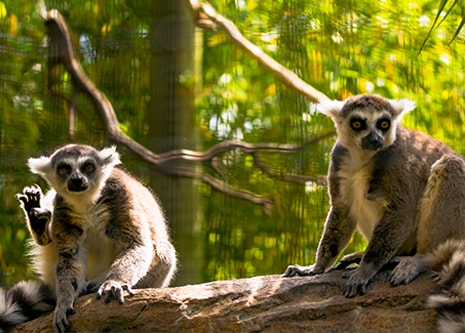
- VisitSupport Happy HollowDONATE TODAYExploreSupport Happy HollowDONATE TODAYLearnSupport Happy HollowDONATE TODAYSupportToday’s Hours: CLOSEDZoo in the Hollow
American alligator

Scientific name: Alligator mississippiensis
Family: Alligatoridae
Order: Crocodylia
Class: Reptilia
Range: Southeastern United States
Habitat: Wetland
Lifespan: Typically 35 to 50 years; oldest on record was over 75 yearsWhat do they look like?
American alligators are large, powerful reptiles. As adults, females average 8 to 9 feet long while males average 11 to 12 feet. Their long tail is used for propulsion while swimming, as well as for defense. Although American alligators typically weigh 170-800 pounds, large males have been recorded at up to 1,000 pounds. They are dark grey in color with rounded bodies, thick limbs, and broadheads. Juveniles have distinct yellow bands around their bodies which fade as they grow. They have partially webbed feet to aid in swimming. Their eyes and nostrils are located high on the head so that they can rest or hunt while being submerged in the water.How do they behave?
As ectotherms, American alligators cannot make their own body heat and must bask in the sun
to raise their body temperature. American alligators are capable of quickly lunging short
distances and are agile swimmers. They have one of the strongest measured bites of any
animal. American alligators have sharp teeth for catching, tearing, and holding prey, but they
do not chew their food. They swallow small stones that remain in their gizzards, aiding in
digestion by breaking down food. American alligators will dig holes called burrows that serve
as their shelter. When these burrows are later abandoned, they will often fill with water and
serve as microhabitats for several other species in the area, such as fish and turtles.What do they eat?
American alligators are opportunistic carnivores and their diet is largely determined by what is
available. Hatchlings primarily eat invertebrates such as insects, arachnids, mollusks, and
worms. As they grow, they start eating fish and eventually larger prey. Adult American
alligators are capable of catching larger mammals such as raccoons, opossums, nutrias, and
even deer. At Happy Hollow, they eat rodents, chicken pieces, fish and other meat.How are they born?
American alligators breed in the spring. Males make a deep bellow to attract a mate. Females
build nests made of sticks, leaves, and mud near the water. Females will lay 20 to 50 white eggs, after which they will cover them with more vegetation. The vegetation releases heat as it decomposes, keeping the eggs warm. The temperature at which the eggs are incubated will
determine the sex of the embryos. Males result from higher incubation temperatures while females result from lower temperatures. The mother will guard the nest for approximately 65 days. The hatchlings emit a high-pitched noise as they emerge from the eggs, signaling to their
mother to dig them out of the nest. The mother will protect the babies for five to six months and may even transport them in her mouth or on her back. Juveniles are preyed upon by a variety of predators until they reach maturity. As adults, they have no natural predators.Conservation
The Endangered Species Act of 1973 listed the American alligator as Endangered due to their
dwindling numbers in the wild. However, thanks to the conservation work of several state,
government, and private organizations, American alligator populations fully recovered by 1987.
The American alligator’s current conservation status is listed as Least Concern by the
International Union for Conservation of Nature . You can help maintain this status by
spreading the word about the important role American alligators play in their wetland
ecosystems. For more information on how you can help preserve wetlands right here in
California check out http://www.waterboards.ca.gov
Zoo on the Hill
Located across from the Keep-Around Carousel is the Zoo on the Hill. Learn about wildlife up close during daily meet-and-greets, leap like a lemur on the playground, brush and feed the goats,, or take a peek inside Doc’s Critter Care building and the Ranch House. Double-H Ranch features a combination of animal exhibits, including giant anteaters and red ruffed lemurs, as well chickens and domesticated animals that are docile enough to touch.
See Animals
Education Ambassadors
From camps and classes to scout badges and sleepovers, Happy Hollow education programs have something for everyone! The zoo education program offers a broad range of hands-on, engaging programs and public presentations featuring education ambassador animals. These encounters are designed to connect you to wildlife and the conservation of their habitats around the world.
See AnimalsVisit Us Today
Plan an unforgettable experience at San Jose’s family-friendly park and zoo.
Learn More